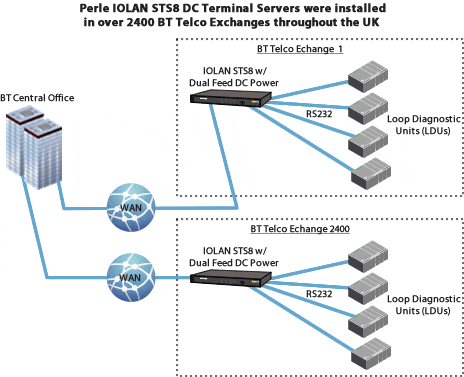BT chooses Perle Terminal Servers for remote access and management of LDU’s

The “residential phoneline” section of BT was operating a mixed X.25 and Ethernet environment. The goal for BT was to get rid of the X.25 WAN and have a direct IP connection to Loop Diagnostic Units (LDU). This would enable them to communicate with the exchanges at a much higher speed, allowing them to service their customers more efficiently and quickly. While moving to an IP Network, it was important not to replace all of the existing infrastructure that was not at the end of its lifecycle.
The Scenario:
A residential customer reports that their phone line appears not to be working. At BT’s headquarters a test of the line, via the exchange, is initiated. To test a phone line engineers connect to a LDU (Loop Diagnostic Unit) at the exchange that checks the line. This first check indicates whether the line is clear and operating or whether further investigation is required and an Engineer needs to be dispatched.
This initial check was previously done across the X.25 Network. A user on a remote network opened an application, entered an IP address and a port number, and sent a command to an LDU across the LAN and then through X.25 pads to a serial connection on the LDU. The LDU communicates via a serial link to request the specific line to test. The HQ gives the LDU the line or a batch of lines, the LDU tests and feeds back to the user on the LAN.
BT wanted a direct IP connection to the LDU, replacing the X.25, which would enable them to communicate with the exchanges at a much higher speed, allowing them to service their customers more efficiently and quickly. There was no requirement to replace the LDU, as this had not reached the end of its lifecycle. However there was a need to be able to access it over Ethernet, securely and remotely.
Most exchange sites have one LDU. Some have more than one requiring a higher number of serial ports. Each LDU has 4 serial ports, consisting of an admin port, a port to the exchange, an Xserver port, and a serial port for Ethernet Connectivity.
Working closely with Perle Systems, a suitable product from the IOLAN Terminal Server range was quickly identified. The selection process focused on key requirements including:
- Redundancy – a backup feature to support the LDU’s in the event of loss of power
- Security – meeting BT’s “Safe to Connect” Standard
- Support – local UK based support.
IOLAN Terminal Servers were installed at the Exchange sites, and connected to the LDU’s.
IOLAN Terminal Servers from Perle Systems helped BT keep their LDU’s while accessing them over IP remotely.
To meet the redundant power requirement, Perle IOLAN Terminal Servers were connected to 2 fused 50v feeds generated by a dedicated Wind Farm with a centralised earth going into the primary and secondary DC power inputs. The dual feed DC IOLAN Terminal Servers from Perle operate so that in the event the primary power source is depleted, the IOLAN pulls power from the secondary source and is able to switch back and forth as necessary, thereby ensuring continuous operation.
In addition, after extensive testing, Perle IOLAN Terminal Servers underwent and passed BT’s “Safe to Connect” requirements, which is a series of requirements more stringent than normal Telco testing would require. The whole of the IOLAN Terminal Server range was tested and met the various standards needed.

